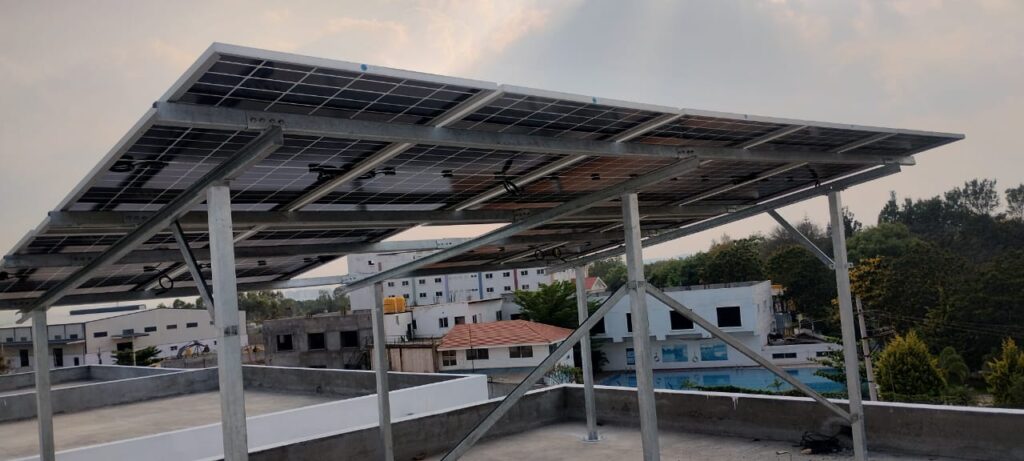
With rising electricity costs and increasing awareness of renewable energy, more homeowners in India are switching to solar rooftop systems. But before installing one, it’s important to understand the types of solar systems, how they work, and which is the best fit for your home.
In this blog, we’ll explore in detail:
✅ What is a solar rooftop system
✅ Different types of rooftop solar systems
✅ How each type works
✅ Pros and cons of each
✅ Which one suits your house best
✅ Government references and useful links
☀️ What Is a Solar Rooftop System?
A solar rooftop system is a power generation setup installed on the roof of a home, apartment, or commercial building.
It captures sunlight through solar photovoltaic (PV) panels, converts it into electricity, and either uses it instantly, stores it in batteries, or exports it to the grid.
India’s rooftop solar journey began around 2010, when the Jawaharlal Nehru National Solar Mission (JNNSM) was launched to promote solar power.
Today, under the PM-Surya Ghar: Muft Bijli Yojana (2024), homeowners can get up to ₹78,000 in government subsidy for installing rooftop systems.
🔗 Reference: https://pmsuryaghar.gov.in
🔗 MNRE Official Site: https://mnre.gov.in
⚡ Types of Solar Rooftop Systems
There are three main types of solar rooftop systems:
1️⃣ On-Grid (Grid-Tied) Solar System
How It Works:
- Connected directly to the state electricity grid (like BESCOM, TANGEDCO, etc.).
- The solar panels generate electricity during the day.
- Any excess power is exported to the grid through a net meter.
- When solar power is insufficient (night or cloudy days), you draw electricity from the grid.
Example:
A 3 kW on-grid system can power your home appliances (fans, lights, fridge) and export extra power to the grid, reducing your bill.
Pros:
✅ Lowest installation cost
✅ Earn from net-metering (exported units)
✅ Minimal maintenance
✅ Ideal for homes with reliable grid supply
Cons:
❌ Doesn’t work during power cuts (no backup)
❌ Requires grid connection and approval from DISCOM
Best For:
Urban homes and apartments where electricity is stable and uninterrupted.
🔗 More info: BESCOM Solar Rooftop Program
2️⃣ Off-Grid Solar System
How It Works:
- Works independently from the grid using solar panels + batteries.
- Electricity generated during the day charges the batteries.
- Power stored in the batteries runs your home at night or during outages.
Example:
A 5 kW off-grid system can run a small home, including fans, lights, and TV, even during blackouts.
Pros:
✅ Works even without grid power
✅ Best for remote or rural areas
✅ Complete independence from electricity bills
Cons:
❌ Higher upfront cost (batteries are expensive)
❌ Requires periodic battery maintenance/replacement
❌ Battery backup is limited to capacity
Best For:
Homes in rural or semi-urban areas with frequent power cuts or no grid access.
3️⃣ Hybrid Solar System
How It Works:
- Combines the features of on-grid and off-grid systems.
- Connected to both the battery and the electricity grid.
- Uses solar power first, stores excess energy in batteries, and exports any remaining to the grid.
Example:
A 10 kW hybrid system can run a large independent home with backup and grid connectivity — perfect for modern villas or industrial use.
Pros:
✅ Continuous power (with or without grid)
✅ Smart energy management
✅ Can sell excess power to the grid
✅ Future-ready and efficient
Cons:
❌ Higher cost due to inverter and batteries
❌ Slightly more maintenance
Best For:
Homes and businesses that want uninterrupted power + lower bills.
⚙️ Comparison Table
| Feature | On-Grid | Off-Grid | Hybrid |
|---|---|---|---|
| Grid Connection | ✅ | ❌ | ✅ |
| Battery Backup | ❌ | ✅ | ✅ |
| Cost | Low | Medium | High |
| Maintenance | Low | Medium | Medium |
| Power During Outage | ❌ | ✅ | ✅ |
| Net Metering Benefit | ✅ | ❌ | ✅ |
| Ideal For | City homes | Rural areas | Modern homes/businesses |
💡 Which Solar Rooftop System Is Best for Your House?
If you live in a city with stable electricity, the On-Grid System is the best option — it’s affordable, efficient, and offers BESCOM/MNRE subsidy benefits.
If you experience frequent power cuts or live in a rural area, an Off-Grid or Hybrid System is ideal, depending on your budget and power needs.
🧠 Pro Tip from Experts
Always install your solar system through an MNRE-approved vendor to ensure quality, performance, and eligibility for government subsidy.
Check the vendor list here 👉 https://solarrooftop.gov.in/
📰 Recent Developments in Solar Technology (2024–2025)
- India crossed 11 GW rooftop solar installations as of 2024.
- New R&D focuses on bifacial panels, smart inverters, and AI-based solar monitoring.
- Research institutions like IIT Bombay and NISE (National Institute of Solar Energy) are developing higher-efficiency PV cells and long-life batteries.
🔗 Reference: MNRE Annual Report 2024-25
🔗 News: The Hindu BusinessLine – Rooftop Solar Growth
🌱 Final Thoughts
Choosing the right solar rooftop system depends on your location, power usage, and budget.
For most Indian households, an on-grid system provides the best balance between cost, savings, and convenience — especially when combined with the PM-SURYAGHAR subsidy.
If you’re ready to go solar, our experts at Brindavan Solutions can guide you through every step — from system selection and installation to subsidy approval and maintenance.
Thank you for taking the time to read this article
📞 Contact: +91 86608 21746
📧 Email:brindavansolutions@gmail.com
🏢 Company: Brindavan Solutions, Bangalore
Interested in solar? Get your free proposal and site survey with just one click! https://wa.me/918660821746
